
Machine wash
When you see an image of a tub filled with water, it means the garment can be machine washed. If you see that same symbol with an X through the center, the garment should not be washed in the machine.


Last Updated: June 14, 2021
Get the low-down on the proper way to wash and dry your favorite garments with this laundry symbol guide, where we decode the imagery of each symbol you may have seen on the tags of your clothes or textiles.
Clothing should be a comfortable expression of your personality, but keeping your favorite pieces looking like new requires proper care. Before you throw your next load in the washer and dryer, take a couple minutes to learn all of the laundry symbol meanings. (We found a few we didn’t know ourselves!)

Wondering who Grove is, what types of products we offer, and how to get a free gift set when you sign up? Learn more about flexible monthly shipments, customizing your shipment, and joining millions of happy households — no monthly fees or commitments required.

Laundry symbols are found on the labels of every article of clothing or textile you purchase. These tags are usually found on the center back neckline, along the lower side seam, or along the waistband or hem.
The tags include a line of symbols that alert you to the correct washing method, drying method, and whether or not the piece is dry clean only.
The first step is to determine the washing method by decoding the different washing machine symbols for machine wash, handwash, or dry clean.
Washing instruction symbols can differ in design, especially stylistically, but the basic ideas remain the same from one garment to the next.

When you see an image of a tub filled with water, it means the garment can be machine washed. If you see that same symbol with an X through the center, the garment should not be washed in the machine.

The tub of water with a hand on top indicates the clothing should only be washed by hand, usually because the item is too delicate for the vigorous machine cycle.

If you see a symbol with an open circle, the garment is dry clean only and cannot be washed at home.
If you see an X through that same symbol, it means the item should not be dry cleaned.
Chances are, your washing machine offers many different washing cycles. Fortunately, the symbols take the guesswork out of choosing the right one.
It all starts with the traditional washing machine symbol, which will either feature no lines underneath, one line underneath, or two lines underneath.

If the tub of water features no line underneath, go ahead and use the normal washing cycle on your machine.
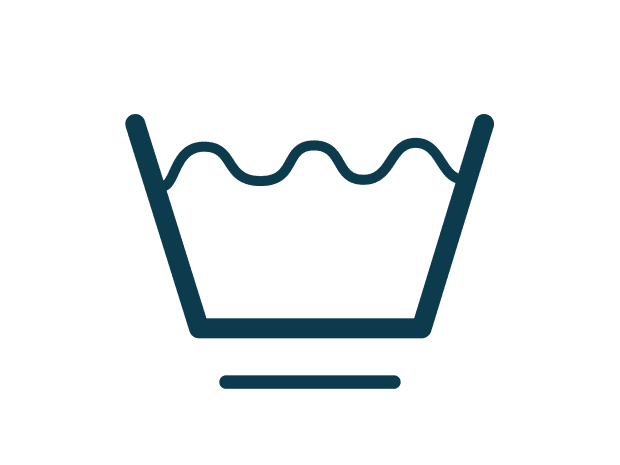
If the tub symbol features a single line underneath, it requires the permanent press cycle of your washing machine.
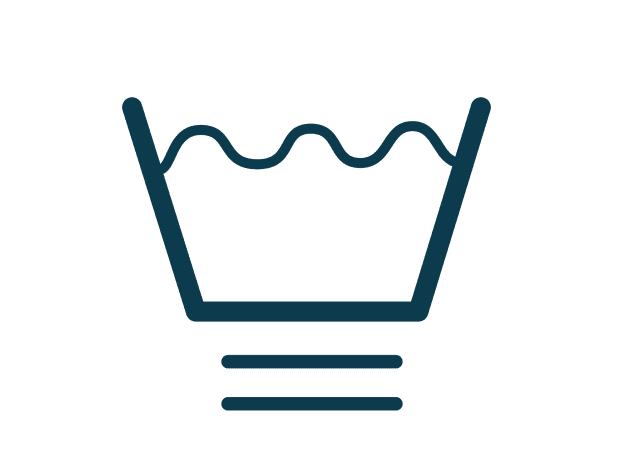
If the machine wash symbol has two lines, it’s a delicate garment that requires a gentle cycle when washing.
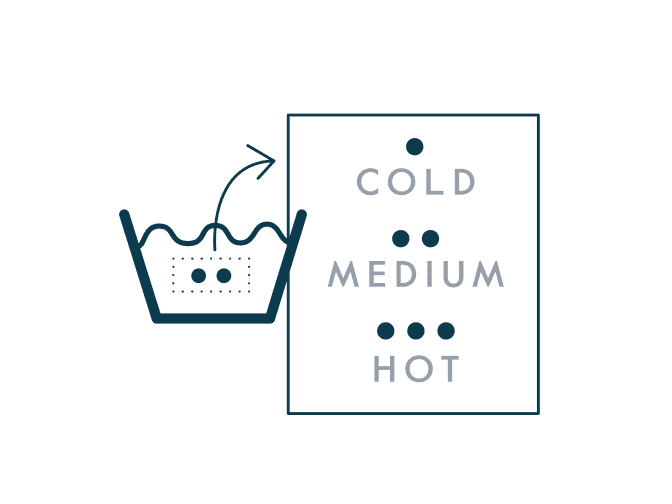
There are three different symbols that indicate the washing temperature that’s appropriate for the garment. This is basically the machine wash symbol with the addition of one, two, or three dots in the middle.
A machine wash symbol with one dot allows for temperatures between 65 and 85 degrees Fahrenheit. If you’re washing a favorite item, consider washing clothing in cold water.
Two dots allow you to machine wash the item at temperatures up to 105 degrees Fahrenheit.
Three dots indicate durable fabrics you can wash at temperatures up to 120 degrees Fahrenheit.
Sometimes, adding a bit of bleach to your washing cycle is a way to brighten up your whites. Make sure the materials used in the garment can tolerate bleach to avoid potential damage.

A symbol with a triangle means the article of clothing is compatible with chlorine bleach.

If you see a triangle with an X through it, stay away from bleach altogether.

A triangle with two additional diagonal lines means you can use bleach as long as it’s the non-chlorine variety.
GROVE TIP
End the stress over spills by pre-treating your favorite clothing with a non-toxic stain treatment. Here’s what Grove writer Carly Reynolds thought when she tried a natural stain remover from Grove.
The type of fabric, the embellishments on the garment, and the construction of the piece itself all help determine whether the item is safe to throw in the dryer or if a more delicate drying method is necessary.
Adding natural dryer sheets or dryer balls to your laundry routine will provide a soft, fresh finish.
When you’re shopping for new clothes, make a habit of checking out the various drying symbols to make sure they’ll not only be a stylish, but also convenient, addition to your wardrobe.

A square with a large circle in the middle is the symbol resembling a dryer, indicating the piece is safe for tumble drying. If there’s a big X through this symbol, it should not be thrown in the dryer.

When the dryer is just too harsh for your clothing, you may notice a hang dry symbol. This varies in look, but it often features a clothesline element within a square.

Sweaters and other items that can stretch out easily aren’t candidates for hang drying or tumble drying. When you see a symbol with a square and a line, you need to allow that item to dry flat.

When you go from the washer to either a clothesline or a dry flat situation, the tendency can be to wring out excess water from the garment. If you see a twisting symbol with an X through it, hold off on wringing out the fabric because it could cause damage.
Once you know you can throw your clothing in the dryer, you need to determine the proper dryer setting to use. There are various versions of the tumble dry symbol that will help you select the proper temperature.
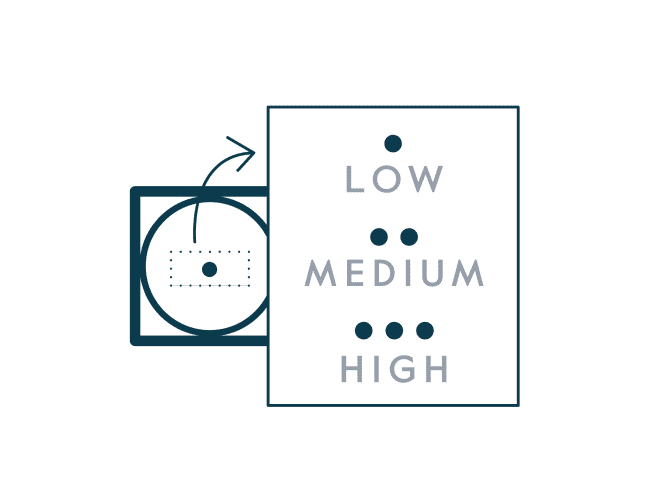
The tumble dry symbol with one dot in the center indicates the dryer should be set on the lowest temperature setting.
If you see two dots in the center of the symbol, a medium temperature setting is appropriate for the garment.
Durable fabrics may have three dots in the center of the symbol, which means the item is suitable for the highest heat settings.
If the center circle of the icon is filled in completely, look for the no heat or air option on your dryer.
Getting that just-from-the-cleaners feeling at home requires a good pressing of an iron, but not all fabrics hold up to the heat. Be sure to check for an iron symbol on each piece of clothing.

If you see the shape of an iron with one, two, or three dots in the center, you are safe to iron those garments. One dot indicates low heat, two dots allow for medium heat, and three dots allow for high heat.

If that same iron symbol features a big X through the center of the image, halt the presses because that fabric is not safe for ironing.

You may see an iron symbol with an X below the iron instead of through the iron. This symbol means you can carefully iron the garment, but you should not add water to the iron to create steam.
Understanding the different clothing tag symbols won’t just help you select the right items for your wardrobe — it will also help you preserve the quality of your favorite items for longer.
For an even better understanding of the art and science of laundry — and how to do it naturally — read our Natural Laundry Guide for laundry hacks, tips, and tricks from the cleaning experts at Grove.
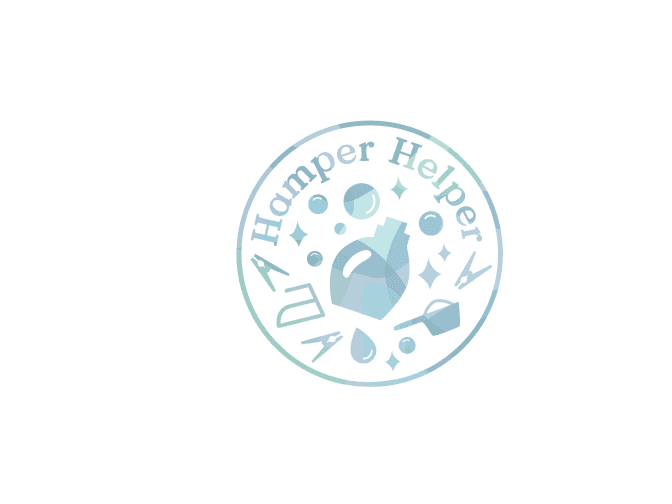
No laundry problem is too big or washing conundrum too perplexing with a little support from our Hamper Helper guides. From how to handle down pillows to the secret behind ridding athletic gear from any lingering funkiness, our tips and tricks will help make laundry day's toughest tasks a thing of the past.

With our step-by-step guide, we’ll show you how to wash white clothes to make them shine bright.

See how making the switch from warm to cold water on laundry day can help save you money (and your clothes) while reducing your carbon footprint.

Are wool dryer balls better than dryer sheets? Learn the basics of this sustainable swap, including how to use them and common mistakes.

Follow this step-by-step care guide on how to wash weighted, electric, wool, fleece, and more blankets naturally.